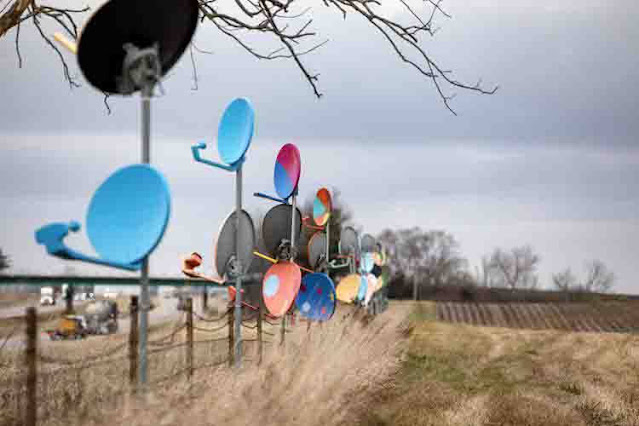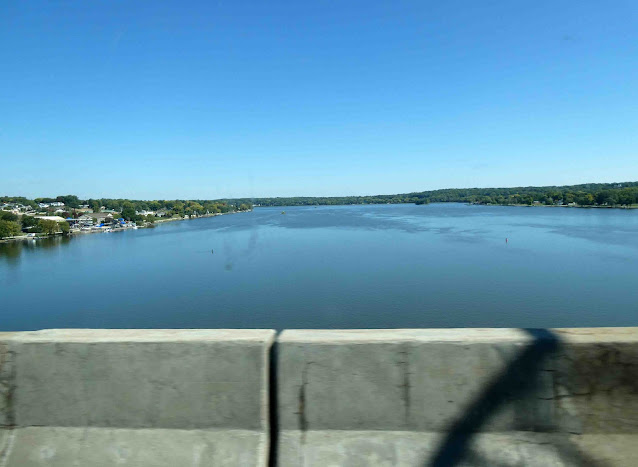We passed into Iowa yesterday afternoon, and we find ourselves in the Mississippi River port city of Dubuque. I don't think either of us has ever been to Dubuque before, although I used to have family in Des Moines. I'm also aware of having extended family in the state, although I'd be hard pressed to tell you where they live...Ames, I think. The Wise family...maybe you know them.
Wanda left this comment: You are about 30 miles south of me right now. Good black dirt and lots of cornfields and you know you are in Illinois.I responded: The corn hasn't been harvested and the stalks are all dried up. Must have been a bad year for corn.To which Wanda responded: The corn is harvested after the corn stalks are totally dry. Harvesting will be starting soon and go all the way through November for the farmers with lots of fields. I think it turned out to be an average year for yield with a slow start and dry conditions and then average rain after that.Me: Interesting. I’m thinking this corn will become canned or frozen corn without cobs. When I see whole corn cobs in the grocery store, they are green.Wanda: This is field corn for feed for animals. Sweet corn is done for the year.
Well, duh. It never occurred to me there were different grades of corn for human consumption and animal consumption. Now it all makes sense. My "city girl" is showing. Thank you for educating me, Wanda. I appreciate it.
We made a pit stop about halfway to our destination. There, we found some pretty blooming things.
We passed a couple of items of interest along our way. First, this "Alien Dish Farm," created by retired farmer and Illinois Farm Bureau member Carl Walter. You can read the article about his creation right here...and I recommend it. It'll give you a chuckle.
(Image credit: Catrina Rawson for Farm Week Now)
Okay, so that was fun. Continuing on our way...more barns.
In 1870, Alfred Hurst came to the area, having heard of the limestone formations along the banks of the Maquoketa River. He then found what he considered the best quality limestone rock to produce the whitest, purest, and most adhesive lime in the marketplace. He constructed a small pot kiln and started producing powder lime. He then erected the first draw kiln in 1871, with the other 3 following soon after. In the 1st year, production reached 100 barrels a week, with a total of 3200 barrels for the year. At the company’s peak, the kilns would produce 8000 barrels of lime a day!
Okay, and then we were closing in on our final destination. Just as Wanda predicted, we noticed some of the corn fields were being harvested.
In other news, our combination convection/microwave oven gave up the ghost last night. Enter Mr. Fix-It Mike to figure out the problem. As it turns out it blew a fuse inside its guts. As I'm writing this, he's tearing into it, and we'll be able to pick up a fuse at a local hardware store. So far on this trip, he's fixed the refrigerator, the hydraulic jacks and slides, and now the microwave. He really should be wearing a cape, indicating his superhero status. What more could possibly go wrong? I'm just glad he's able to fix this stuff. We can usually find a work-around, but it can make everything about RV life so much more inconvenient.
Okay, so this being a Sunday, we want to try to get to the museum early. Time for me to get going on some breakfast.




























11 comments:
Even through you and I are in different boats, you in your boat and we our canoe, we share the same river of life. What befalls me befalls you. And downstream, downstream in this river of life, our children will pay for our selfishness, for our greed, and for our lack of vision. ~ Oren Lyons
It was a joy today to read your post as I live in Dubuque, Iowa.So nice to see your journey brought you here.Enjoy your visit to the National River Museum and Aquarium. Safe journey home. From Fran
Silly me, I'm a city girl too. I knew cattle were given corn to eat, but I had no idea it was harvested after the corn stalks had dried and turned brown. Very interesting. Thanks Wanda!
I enjoyed your email exchange with Wanda! I did know the difference, but only because my grandfathers were both farmers, and grew corn for cattle consumption. They always referred to it as feed corn.
Sandra B
scb304@juno.com
Just a little clarification, the Hurstville Lime kilns are in Maquoketa, Iowa. Jackson is the name of county just south of Dubuque.
Can you stand one more corn "lesson"? Some dried corn is also people food.
"Dent" corn, so called because, when dry, the kernels have dents, is also made into both milled products (cornmeal, corn bread, and corn flakes) and nixtamalized products {hominy corn, grits, masa, and corn nuts). Polenta, a cornmeal, is made from a close, less starchy cousin: flint corn. Many kinds of dried corn can be nixtamalized (soaked in an alkaline solution then hulled and repeatedly rinsed, making more of the nutrition accessible to people). Masa becomes corn tortillas, tamales, corn chips, etc.
Let's not even talk about corn liquor, corn oil, corn starch, or corn syrup. (The interweb and I have been having fun today. I just learned that sweet corn is technically underripe corn!) And now I'll have to make some corn bread with masa harina rather than cornmeal just to see how different it tastes.
Since Ruth is educating you further on corn, I found a pretty good cornbread for two recipe the other day (although you probably have made one for yourself already, I'm guessing). Fun to see those familiar sights - you are just 4 hours away from us. I'm waving, and looking forward to hearing about the museum visit!
Oh dear you asked the dreaded question…what more could go wrong. I learned years ago to never utter those words. Because whatever else could go wrong generally would.
I enjoyed the further education by Ruth. I knew there had to be some kind of dried corn that made cornmeal but it wasn't grown on the farms I lived on. I pretty much just knew field corn, sweet corn, soybeans, oats and alfalfa. The stalks from oats made bales of straw for cattle bedding and the alfalfa was also baled as hay to be eaten by animals. I left all of that behind 63 years ago and moved to the big city, population 2700.
Always a yay from me when I see barns and it was such fun to read about the sat dishes AND the Christmas trees he does.
It would be fun to see the Mississippi River and I have to admit I've always wanted to take a journey on one of their paddleboats (if they even still exist).
I live across the street from Cal Poly Pomona's Spadra Farm. I stopped by once to take some photos of the corn crop & talked to a guy that was working there. He told me that that particular crop would be "silage" for the Cal Poly livestock.
I just visited Mr. Google & discovered that the Farm has recently been given an Organic certification! I haven't been to the Cal Poly Farm store on campus in quite a while. I should check it out again.
Happy Trails!
Post a Comment